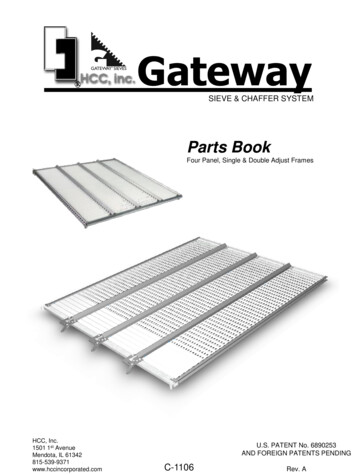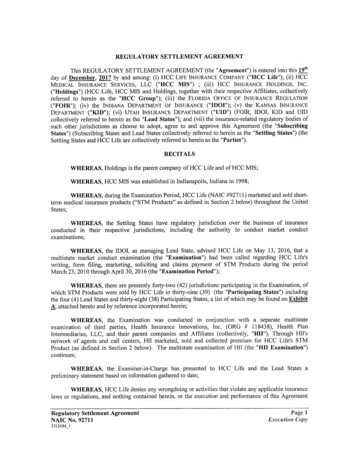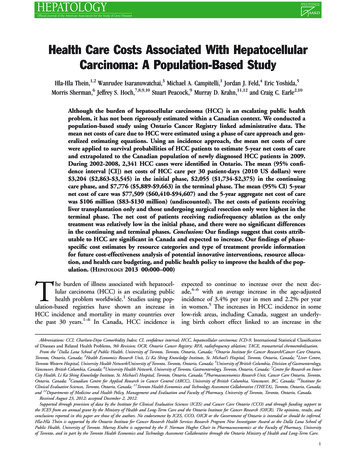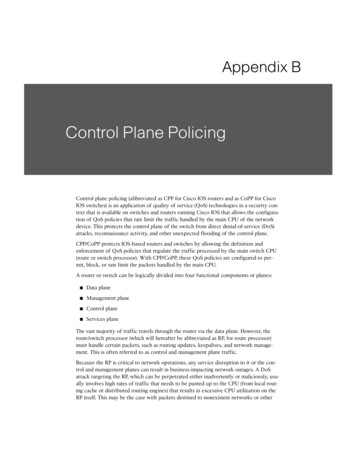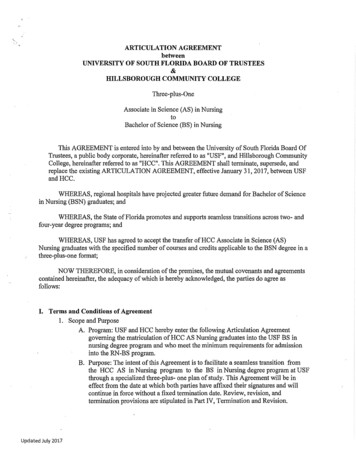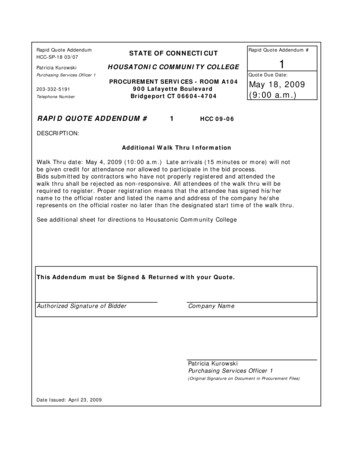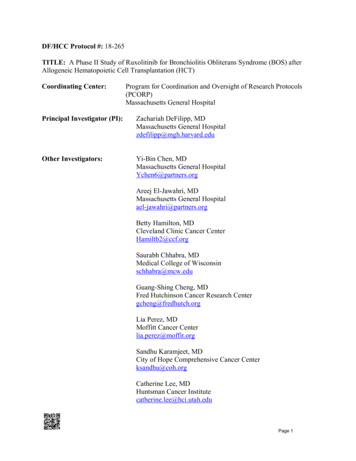
Transcription
DF/HCC Protocol #: 18-265TITLE: A Phase II Study of Ruxolitinib for Bronchiolitis Obliterans Syndrome (BOS) afterAllogeneic Hematopoietic Cell Transplantation (HCT)Coordinating Center:Program for Coordination and Oversight of Research Protocols(PCORP)Massachusetts General HospitalPrincipal Investigator (PI):Zachariah DeFilipp, MDMassachusetts General Hospitalzdefilipp@mgh.harvard.eduOther Investigators:Yi-Bin Chen, MDMassachusetts General HospitalYchen6@partners.orgAreej El-Jawahri, MDMassachusetts General Hospitalael-jawahri@partners.orgBetty Hamilton, MDCleveland Clinic Cancer CenterHamiltb2@ccf.orgSaurabh Chhabra, MDMedical College of Wisconsinschhabra@mcw.eduGuang-Shing Cheng, MDFred Hutchinson Cancer Research Centergcheng@fredhutch.orgLia Perez, MDMoffitt Cancer Centerlia.perez@moffit.orgSandhu Karamjeet, MDCity of Hope Comprehensive Cancer Centerksandhu@coh.orgCatherine Lee, MDHuntsman Cancer Institutecatherine.lee@hci.utah.eduPage 1
DF/HCC Protocol #: 18-265Protocol Version Date: October 21, 2021IND #: 140710IND Sponsor: Zachariah DeFilipp, MDProtocol Type / Version # / Version Date: October 21, 20212
DF/HCC Protocol #: 18-265Protocol Version Date: October 21, 2021SCHEMA3
DF/HCC Protocol #: 18-265Protocol Version Date: October 21, 2021TABLE OF CONTENTSSCHEMA.31.OBJECTIVES .131.1Study Design.131.2Primary Objectives.131.3Secondary Objectives.131.4Exploratory Endpoints .132.BACKGROUND .142.1Allogeneic hematopoietic cell transplantation.142.2Bronchiolitis obliterans syndrome .142.3Ruxolitinib .142.4Rationale for Ruxolitinib in cGVHD.152.5Clinical Experience in GVHD .152.6Correlative Studies Background .162.7Patient-Reported Outcomes .163.PARTICIPANT SELECTION.173.1Eligibility Criteria .173.2Exclusion Criteria .183.3Inclusion of Women and Minorities .194.REGISTRATION PROCEDURES .194.1General Guidelines for DF/HCC Institutions .204.2Registration Process for DF/HCC Institutions.204.3General Guidelines for Other Investigative Sites .204.4Registration Process for Other Investigative Sites.205.TREATMENT PLAN.215.1Pre-Treatment Criteria .215.2Baseline.225.3Treatment Regimen.225.4Subsequent Cycles .235.5Agent Administration.235.6General Concomitant Medication and Supportive Care Guidelines.235.7Criteria for Taking a Participant Off Protocol Therapy.245.8Duration of Follow Up.255.9Criteria for Taking a Participant Off Study .256.STUDY ASSESSMENTS .256.1Pulmonary Function Test.256.2Six Minute Walk Test .266.3Chronic GVHD NIH Consensus Scoring .266.4Steroid Dose.264
DF/HCC Protocol #: 18-265Protocol Version Date: October 21, 20216.56.66.76.8Patient-Reported Outcomes .26Adverse Events .27Blood Draw.27Off Treatment Assessments .287.DOSING DELAYS/DOSE MODIFICATIONS .288.ADVERSE EVENTS: LIST AND REPORTING REQUIREMENTS .298.1Adverse Event List for Ruxolitinib.298.2Definitions.308.3Adverse Event Characteristics .328.4Expedited Adverse Event Reporting.328.5Expedited Reporting to Incyte .338.6Expedited Reporting to the Food and Drug Administration (FDA) .348.7Expedited Reporting to Hospital Risk Management .348.8Routine Adverse Event Reporting .359.PHARMACEUTICAL INFORMATION FOR RUXOLITINIB .359.1Description.359.2Form.359.3Storage and Stability .369.4Compatibility .369.5Handling.369.6Availability .369.7Administration .369.8Ordering .369.9Accountability.379.10 Destruction and Return .3710.BIOMARKER, CORRELATIVE, AND SPECIAL STUDIES .3711.STUDY CALENDAR .3812.ENDPOINT ASSESSMENTS.4012.1 Primary Endpoints .4012.2 Secondary Endpoints .4013.DATA REPORTING / REGULATORY REQUIREMENTS.4113.1 Data Reporting .4113.2 Data Safety Monitoring.4113.3 Multicenter Guidelines.4114.STATISTICAL CONSIDERATIONS.4215.PUBLICATION PLAN .44REFERENCES .455
DF/HCC Protocol #: 18-265Protocol Version Date: October 21, 2021APPENDIX APERFORMANCE STATUS CRITERIA .48APPENDIX BMULTICENTER GUIDELINES.49APPENDIX B .49Dana-Farber/Harvard Cancer Care .491.INTRODUCTION .601.1Purpose.601.2Multi-Center Data and Safety Monitoring Plan Definitions.602.GENERAL ROLES AND RESPONSIBILITIES .612.1DF/HCC Sponsor .612.2Coordinating Center.622.3Participating Institution.623.DF/HCC REQUIREMENTS FOR MULTI-CENTER PROTOCOLS .633.1Protocol Distribution.633.2Protocol Revisions and Closures .633.3Informed Consent Requirements .643.4IRB Documentation .643.5IRB Re-Approval .643.6Participant Confidentiality and Authorization Statement .653.7DF/HCC Multi-Center Protocol Registration Policy.653.8DF/HCC Protocol Case Number.663.9Safety Assessments and Toxicity Monitoring .673.10 Data Management .684.REQUISITIONING INVESTIGATIONAL DRUG.685.MONITORING: QUALITY CONTROL .695.1Ongoing Monitoring of Protocol Compliance .695.2Monitoring Reports.705.3Accrual Monitoring.706.AUDITING: QUALITY ASSURANCE .706.1Audit Plan: NCI Sponsored Trials .716.2DF/HCC Internal Audits .716.3Audit Notifications.716.4Audit Reports .716.5Participating Institution Performance .71APPENDIX CDRUG DIARY.72APPENDIX DFACT-BMT .756
DF/HCC Protocol #: 18-265Protocol Version Date: October 21, 2021.757
DF/HCC Protocol #: 18-265Protocol Version Date: October 21, 2021.77APPENDIX EHUMAN ACTIVITY PROFILE (HAP).788
DF/HCC Protocol #: 18-265Protocol Version Date: October 21, 2021.799
DF/HCC Protocol #: 18-265Protocol Version Date: October 21, 202110
DF/HCC Protocol #: 18-265Protocol Version Date: October 21, 2021.80APPENDIX FMMRC DYSPNEA SCALE .82APPENDIX GLEE CHRONIC GVHD SYMPTOM SCALE .8311
DF/HCC Protocol #: 18-265Protocol Version Date: October 21, 2021.8312
DF/HCC Protocol #: 18-265Protocol Version Date: October 21, 20211. OBJECTIVES1.1Study DesignThis is a prospective, phase II, multi-center clinical trial in subjects who develop BronchiolitisObliterans Syndrome (BOS) after HCT. Patients will be enrolled into one of two cohorts: A) newly-diagnosed BOS ( 6 months since the diagnosis of BOS), or B) established BOS ( 6 months since the diagnosis of BOS)1.2Primary ObjectivesTo evaluate the treatment effect of ruxolitinib in patients who develop Bronchiolitis ObliteransSyndrome (BOS) after Hematopoietic Cell Transplant (HCT).The primary endpoint in cohort A – newly diagnosed BOS – is the proportion of patients with asustained, absolute FEV1 increase by 10% after 3 months of treatment with ruxolitinib(compared to baseline measure prior to study enrollment).The primary endpoint in cohort B – established BOS – is the proportion of patients who do notexperience a sustained, absolute decrease in FEV1 by 10% after 3 months of treatment withruxolitinib (compared to baseline measure prior to study enrollment).1.3Secondary Objectives1. To longitudinally assess changes in FEF25-75, RV, DLCO, FEV1/FVC ratio andFEV1/SVC ratio on PFT testing2. To longitudinally assess changes in six-minute walk test3. To longitudinally assess the proportion of subjects with improvements in other chronicGVHD organ manifestations (using the NIH consensus criteria)4. To longitudinally assess the change in systemic corticosteroid dose (as compared tobaseline steroid dose) after starting therapy with ruxolitinib5. To longitudinally assess changes in patient-reported quality of life (FunctionalAssessment of Cancer Therapy- Bone Marrow Transplant (FACT-BMT)), functionalcapacity (Human Activity Profile (HAP)), and dyspnea (Modified Medical ResearchCouncil Dyspnea Scale) in patients on ruxolitinib therapy compared to baselinemeasures prior to study enrollment6. To longitudinally assess patient-reported chronic GVHD symptoms (Lee SymptomScale) in patients on ruxolitinib therapy compared to baseline measures prior to studyenrollment7. To describe the incidence and types of NCI-CTCAE (v4.03) Grade 3-5 SAEs, any UPsor infectious complications that are possibly or probably attributable to ruxolinitibToassess cGVHD progression-free survival at months 3, 6 and 12 after enrollment8. To assess overall survival at months 3, 6 and 12 after enrollment1.4Exploratory Endpoints1. To longitudinally assess changes cytokines, cGVHD biomarkers and immune cellsubsets13
DF/HCC Protocol #: 18-265Protocol Version Date: October 21, 20212. BACKGROUND2.1Allogeneic hematopoietic cell transplantationAllogeneic hematopoietic cell transplantation (HCT) is a potentially curative therapy for a numberof malignant and non-malignant hematologic disorders. The prevalence of chronic graft-versushost disease (GVHD) is 30-70% after allogeneic HCT and is a leading cause of long-termmorbidity and mortality in transplant recipients.1 Chronic GVHD has a wide range ofmanifestations and many complications can emerge from both the disease and its treatment.Pulmonary involvement of chronic GVHD is primarily manifested as bronchiolitis obliteranssyndrome (BOS).2.2Bronchiolitis obliterans syndromeBronchiolitis obliterans syndrome (BOS) is the primary noninfectious pulmonary complicationfollowing allogeneic hematopoietic cell transplantation (HCT). Characterized by subepithelialinflammation in the small airways that leads to fibrotic narrowing of the respiratory bronchioles2,BOS after HCT is considered a moderate/ severe manifestation of chronic GVHD.3-5 The overallprevalence of BOS among all transplanted patients has been reported as 5%, and 10-15% amongpatients with other manifestations of chronic GVHD.6, 7Despite treatment with high-dose corticosteroids and immunosuppressive therapy, BOS remainsassociated with significant impairment in quality of life, morbidity, and mortality.8 The prognosisfor BOS is poor, with a reported 5-year mortality rate of 40-50%.7 Prior retrospective series haveevaluated a number of therapies, including corticosteroids, cyclosporine, azathioprine,antithymocyte globulin, and extracorporeal photopheresis, but these analyses have been limited bysmall patient numbers, retrospective nature, and differences in diagnostic criteria used for BOS.911 A recent phase II trial evaluating the combination of inhaled fluticasone, azithromycin, andmontelukast (FAM) and a brief steroid pulse suggested that this therapeutic approach may haltpulmonary decline in new-onset BOS and permit reductions in systemic steroid exposure.12However, more effective therapeutic options are needed for BOS - both new-onset and progressivecases.2.3RuxolitinibRuxolitinib is an oral inhibitor of the Janus kinase family of protein tyrosine kinases (JAKs), andhas been shown to produce durable clinical benefits in terms of spleen volume reduction andimprovement in constitutional symptoms in patients with polycythemia vera (PV) andmyelofibrosis. An exploratory analysis of patients receiving ruxolitinib also showed improvementin fatigue related symptoms (i.e., tiredness, exhaustion, mental tiredness, and lack of energy) andassociated impacts on daily activities (i.e., activity limitations related to work, self-care, andexercise) as measured by the PROMIS Fatigue 7-item short form total score at Week 24. Patientswho achieved a reduction of 4.5 points or more from baseline to Week 24 in the PROMIS Fatiguetotal score were considered to have achieved a fatigue response. Fatigue response was reported in35% of patients in the ruxolitinib group versus 14% of the patients in the placebo group. Based on14
DF/HCC Protocol #: 18-265Protocol Version Date: October 21, 2021two phase III studies, ruxolitinib was FDA approved for patients with intermediate-II and higherdisease in 2011.13, 14 In 2014, based on the results of two phase III studies in polycythemia vera,ruxolitinib was approved in patients with PV that were refractory or intolerant to standardtherapies.Ruxolitinib represents a novel, potent, and selective inhibitor of JAK1 (IC50 3.3 1.2 nM) andJAK2 (IC50 2.8 1.2 nM) with modest to marked selectivity against TYK2 (IC50 19 3.2nM) and JAK3 (IC50 428 243 nM), respectively. Ruxolitinib is inactive (i.e., 30% inhibition)against 28 additional kinases when tested at 200 nM.Ruxolitinib has high solubility and permeability, (i.e., it is designated as a Class I molecule in theBiopharmaceutical Classification System (BCS)) and exhibits moderate- to-high clearance,volume of distribution and oral bioavailability in preclinical species. The apparent eliminationhalf-life is short ( 5 hr) in all species. The primary clearance pathway is oxidative metabolism.The metabolism by human liver microsomes is catalyzed predominantly by CYP3A4. Because ofthis, the use of strong CYP3A4 inhibitors will be discouraged. In a study using 14C-Ruxolitinibin healthy volunteers, unchanged Ruxolitinib was the predominant circulating drug-related entitywith 2 major circulating metabolites observed, both of which are mono-oxidation products. Themetabolites of Ruxolitinib retain varying degrees of JAK-related pharmacological activity.Excretion was rapid by both urinary and fecal routes with parent drug accounting for 1% of theadministered dose. Tissue distribution studies in rats indicate rapid and complete elimination ofradioactivity in most tissues. Ruxolitinib exhibits high plasma protein binding in humans with anunbound fraction of 3.3%.2.4Rationale for Ruxolitinib in cGVHDThe scientific rationale for this study of ruxolitinib in adults with BOS is based on currentknowledge of cGvHD pathophysiology that begins with activation of host antigen-presenting cells(APC) expressed by damaged tissues and/or pathogens.15 Activated host APC then present hostantigens to donor immune cells, leading to donor T-cell proliferation and inflammatory cytokineproduction. Cytokine dysregulation has also been implicated through observations that high levelsof interleukin (IL)-1β, IFNγ, and tumor necrosis factor (TNF)-α are associated with more severecGvHD.16 These inflammatory cytokines then recruit and induce proliferation of additionalimmune effector cells, thereby perpetuating an adverse cycle of allo-reactive tissue injury andinflammation. Inhibition of JAK1/2 signaling results in reduced proliferation of donor effector Tcells, suppression of pro-inflammatory cytokine production in response to alloantigen, as well asimpairment of antigen presenting cells in vitro and in vivo.172.5Clinical Experience in GVHDThe clinical experience with ruxolitinib in patients with GVHD was recently reported in aretrospective multicenter survey study of 95 patients with steroid-refractory GVHD, of whom 41had chronic GVHD.18 In this study, 29 of 41 patients (71%) with steroid-refractory chronic GVHDpatients had more than one organ system involved. All patients had moderate or severe chronicGVHD. The median number of prior treatments was 3 (range, 1–10). The overall response rate(ORR) to ruxolitinib was 85.4% (35 of 41 patients), with 78% (32 of 41 patients) having a partial15
DF/HCC Protocol #: 18-265Protocol Version Date: October 21, 2021response (PR defined as the discontinuation or long-lasting reduction of all systemicimmunosuppressive therapy by at least 50%) and 7.3% (3 of 41 patients) having a completeresponse (CR defined as the absence of any symptoms related to cGvHD). Only 14.6% (6 of 41patients) of the patients showed no response. The median time to response was 3 weeks afterinitiation of ruxolitinib treatment (range, 1-25). The safety profile of ruxolitinib in steroidrefractory chronic GVHD was generally favorable. Cytopenias were observed in 17% of steroidrefractory chronic GVHD patients, although cytopenias preceded ruxolitinib administration in14.6% of these patients. CMV reactivation was observed in 14.6% of steroid-refractory chronicGVHD patients treated with ruxolitinib. Relapse of the underlying malignancy occurred in 2.4%(1 of 41 patients) of the patients with steroid-refractory chronic GVHD. This frequency iscomparable to other studies and suggests that ruxolitinib treatment is not linked to a higher relapserisk when compared with other currently applied immunosuppressive drugs.Currently, the utility of ruxolitinib as a therapeutic agent for patients with BOS remains unknown.At Massachusetts General Hospital, two patients have been anecdotally treated with ruxolitinib(10 mg BID) for BOS: one patient with newly-diagnosed BOS and one patient with BOS refractoryto multiple lines of therapy. Although neither patient has yet had repeat PFTs performed, bothreported significant improvement in exercise tolerance within 1 month of therapy.We propose a phase II, open label clinical trial to determine if treatment with ruxolitinib in HCTrecipients after the diagnosis of BOS can improve exercise tolerance, quality of life, andpulmonary function test (PFT) parameters.2.6Correlative Studies BackgroundThe goal of the exploratory biomarker assessments is to understand the impact of ruxolitinib onBOS. Therefore, biomarker samples will be collected and exploratory analyses will be performedto assess the effect of ruxolitinib on biomarkers for BOS, pro-inflammatory cytokines, and cellsof the immune system in peripheral blood.Potential mechanisms of action for JAK/STAT inhibition in the prevention of GVHD may includealterations in cytokine signaling, alterations in T-cell trafficking through CXCR3 expression, andeffects on cellular differentiation, antigen presenting cell function and GVHD biomarkers.An exploratory objective of this study will be to evaluate the effects of ruxolitinib on immuneeffectors post-transplant and to measure changes in biomarkers of GVHD. These studies willinvolve the use of clinically annotated bio-specimens obtained from subjects treated on study atpredetermined time points.2.7Patient-Reported OutcomesHealth-related quality of life is negatively impacted in patients who develop BOS following alloHCT.16 Therefore, we will use patient-reported instruments that have been recommended by theNIH Consensus Conference. We will measure quality of life using the Functional Assessment ofCancer Therapies (FACT-BMT); functional status will be measured using the 94-item HumanActivity Profile (HAP); and dyspnea will be measured using the Modified Medical ResearchCouncil Dyspnea Scale (mMRC scale). The Lee cGvHD Symptom Scale will be used to assesspatient-reported chronic GvHD symptoms over time.16
DF/HCC Protocol #: 18-265Protocol Version Date: October 21, 20213. PARTICIPANT SELECTION3.1Eligibility CriteriaParticipants must meet the following criteria to be eligible for enrollment on this study:3.1.1Diagnosis of BOS after HCT. The definition can be made following either the NIHdiagnostic criteria for BOS OR diagnostic criteria for atypical BOS.3.1.1.1NIH diagnostic criteria5 – All of the following criteria must be met:1. FEV1/VC 0.7 or the 5th percentile of predicted.a. FEV1 Forced Experitary Volume in 1 second.b. VC Vital Capacity (Forced Vital Capacity “FVC” or Slow VitalCapacity “SVC”, whichever is greater)c. The 5th percentile of predicted is the lower limit of the 90% confidenceinterval.d. For elderly patients, use the lower limits of normal defined according toNHANESIII calculations.2. FEV1 75% of predicted with 10% absolute decline over less than 2 years.FEV1 should not correct to 75% of predicted with albuterol, and the absolutedecline for the corrected values should still remain 10% over 2 years. Theremote comparator would be an evaluation of PFTs done within 2 years of thePFTs assessment being evaluated to determine eligibility.3. Absence of active infection in the respiratory tract, documented withinvestigations directed by clinical symptoms, such as chest radiographs orcomputed tomographic scans or microbiologic cultures (sinus aspiration, upperrespiratory tract viral screen, sputum culture, bronchoalveolar lavage).4. One of the two supporting features of BOS:a. Evidence of air trapping by expiratory CT or small airway thickening orbronchiectasis by high-resolution chest CT ORb. Evidence of air trapping by PFTs: RV (Residual Volume) 120% ofpredicted or RV/TLC elevated outside the 90% confidence interval(RV/Total Lung Capacity).3.1.1.2Atypical BOS diagnostic criteria19– All of the following criteria must be met:1. FEV1 80% of predicted with 10% absolute decline over the last 2 years orsince transplant. The remote comparator can be an evaluation of PFTs donewithin
DF/HCC Protocol #:18-265 TITLE: A Phase II Study of Ruxolitinib for Bronchiolitis Obliterans Syndrome (BOS) . To longitudinally assess changes in patient-reported quality of life (Functional Assessment of Cancer Therapy- Bone Marrow Transplant (FACT-BMT)), functional . is 30-70% after allogeneic HCT and is a leading cause of long-term


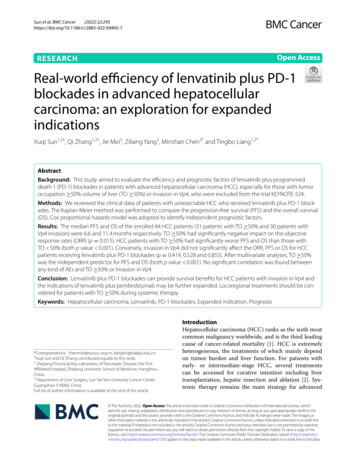
![2020-21 Florida's Optional Innovative Reopening Plan [Hillsborough County]](/img/27/hillsborough-reopenplan.jpg)
